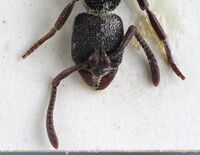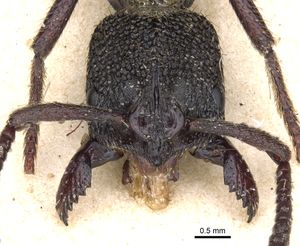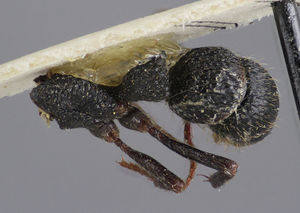Bothroponera berthoudi
| Bothroponera berthoudi | |
|---|---|

| |
| Scientific classification | |
| Kingdom: | Animalia |
| Phylum: | Arthropoda |
| Class: | Insecta |
| Order: | Hymenoptera |
| Family: | Formicidae |
| Subfamily: | Ponerinae |
| Tribe: | Ponerini |
| Genus: | Bothroponera |
| Species group: | pumicosa |
| Species: | B. berthoudi |
| Binomial name | |
| Bothroponera berthoudi Forel, 1901 | |
Specimens have been collected in open habitats, e.g., savanna, thornveld and farmland.
Identification
Joma and Mackay (2015) - A member of the Bothroponera pumicosa species complex. The worker of Bothroponera berthoudi is a relatively large ant (total length 9.60 – 12.00 mm). The mandibles are hairy and coarsely covered with punctures. The anterior medial margin of the clypeus is “u” shaped and slightly bent ventrally, with the disc has a raised smooth area with striae. The upper part of the raised area, between the frontal lobes is rough with a few punctulae, and with a small clypeal carinae. The clypeal wings are punctulate and obliquely striate. The scape barely reaches the posterior lateral corner of the head.
Arnold (1952) considered B. berthoudi to be a race of Bothroponera pumicosa, but it is clear that this species is different from B. pumicosa in that B. pumicosa has long hairs that cover the entire body, which is not the case in B. berthoudi. There are other slight differences between the two species. The anterior medial raised area of the clypeus of B. pumicosa forms a partial carina on the posterior part and a smooth narrowed area on the grooved anterior part. The same character is found in B. berthoudi, but the upper part forms striae instead of a partial carina, the lower part is smooth but wider than that of B. pumicosa. The mandibles have 7 teeth in B. berthoudi, similar to the other B. pumicosa species complex members, whereas B. pumicosa has 8 teeth.
Bothroponera laevissima has the same “u” shaped clypeus as does B. berthoudi, but is easily recognized by the unique sculpture: shiny with scattered punctures. The mandibles have 7 teeth in B. berthoudi and B. laevissima, similar to the other B. pumicosa species complex members.
The body surface of B. berthoudi is densely foveolate, and the fourth abdominal segment is densely covered with foveolae and striae. Basically, the members of the type series consistently differ from the rest of B. pumicosa species complex species in having long erect hairs on most surfaces (except the head) and in lacking a well-defined medial clypeal carina
Bothroponera cariosa and Bothroponera strigulosa have the same “u” shaped lower medial anterior margin of the clypeus, but this area forms a sharp clypeal carinae in both species, which is lacking in B. berthoudi.
Keys including this Species
Distribution
Latitudinal Distribution Pattern
Latitudinal Range: 1.5° to -31.12°.
| North Temperate |
North Subtropical |
Tropical | South Subtropical |
South Temperate |
- Source: AntMaps
Distribution based on Regional Taxon Lists
Afrotropical Region: South Africa (type locality).
Distribution based on AntMaps
Distribution based on AntWeb specimens
Check data from AntWeb
Countries Occupied
| Number of countries occupied by this species based on AntWiki Regional Taxon Lists. In general, fewer countries occupied indicates a narrower range, while more countries indicates a more widespread species. |

|
Estimated Abundance
| Relative abundance based on number of AntMaps records per species (this species within the purple bar). Fewer records (to the left) indicates a less abundant/encountered species while more records (to the right) indicates more abundant/encountered species. |

|
Biology
Castes
Worker
Images from AntWeb
   
| |
| Paratype of Pachycondyla variolosa. Worker. Specimen code casent0902470. Photographer Will Ericson, uploaded by California Academy of Sciences. | Owned by NHMUK, London, UK. |
   
| |
| . | Owned by Museum of Comparative Zoology. |
Nomenclature
The following information is derived from Barry Bolton's Online Catalogue of the Ants of the World.
- berthoudi. Pachycondyla (Bothroponera) berthoudi Forel, 1901f: 344 (w.) SOUTH AFRICA.
- Forel, 1913b: 306 (m.).
- Combination in Bothroponera: Joma & Mackay, 2013: 3.
- Subspecies of pumicosa: Forel, 1913a: 109; Forel, 1913b: 306; Arnold, 1915: 63; Wheeler, W.M. 1922a: 771.
- Junior synonym of strigulosa: Arnold, 1952a: 460 (in text); Bolton, 1995b: 303.
- Status as species: Emery, 1911d: 76; Joma & Mackay, 2013: 3; Joma & Mackay, 2015: 545 (redescription).
- Senior synonym of variolosa: Joma & Mackay, 2015: 545.
- variolosa. Bothroponera variolosa Arnold, 1947: 131, figs. 1, 1a (w.) SOUTH AFRICA.
- Combination in Pachycondyla: Brown, in Bolton, 1995b: 311;
- combination in Bothroponera: Joma & Mackay, 2013: 3; Schmidt, C.A. & Shattuck, 2014: 77.
- Subspecies of cariosa: Arnold, 1960b: 452 (in text).
- Status as species: Arnold, 1952a: 462 (in key); Bolton, 1995b: 311 (error).
- Junior synonym of berthoudi: Joma & Mackay, 2015: 545.
Unless otherwise noted the text for the remainder of this section is reported from the publication that includes the original description.
Joma and Mackay (2015) - The specific epithet “berthoudi” was first used by Forel (1890) as a name for Ophthalmopone berthoudi from South Africa. Later, he used it again to identify and describe the male of Ophthalmopone berthoudi. Wheeler and Wheeler (1971) used the same name to identify larvae of O. berthoudi. In 1901 Forel used the same specific epithet to describe Pachycondyla (Bothroponera) berthoudi. Pachycondyla (Bothroponera) berthoudi has been considered to be a secondary homonym of Pachycondyla (Ophthalmopone) berthoudi, as they were both placed in the same genus (Bolton, 1995), which has caused considerable confusion. In this project, we clearly distinguish between O. berthoudi and B. berthoudi as these now belong to two different genera (Schmidt & Shattuck, 2014).
Description
Worker
Joma and Mackay (2015) - (n=8), HL 2.00 - 2.61, HW 1.75 - 2.25, ML 1.15 - 1.45, EW 0.30 - 0.35, EL 0.30 - 0.45, SL 1.40 - 1.85, FL 2.10 - 2.60, WL 2.75 - 3.85, WPL 3.60 - 4.90, PL 0.90 - 1.30, PW 0.95 - 1.35, PH 1.30 - 1.60, CI 86.20 - 87.50, OI 17.14 - 20.00, MandI 57.50 - 55.56, SI 80.00 - 82.22, PetI 103.84 - 105.56. Mandibles smooth with about 7 teeth; head subquadrate; maximum transversal clypeal length 1.60 mm; compound eyes relatively large; length of malar space 0.40 mm; length from upper edge of eye to edge of posterior lobe 1.00 mm; maximum frontal lobes width 0.75 mm; surface of head, pronotum, mesonotum, mesopleuron, propodeum, lateropropodeum, metapleuron, densely foveolate, moderately shiny; petiolar and postpetiolar surfaces densely covered with larger foveolae than those of mesosoma, moderately shiny; cheek, sides of head, area posterior to eyes, frons covered with weakly defined striae; dorsum of fourth abdominal segment covered with shallow foveolae and striae; fifth-seventh abdominal segments smooth, shiny; basalar sclerite oval in depressed surrounding area; pronotal shoulder rounded, lower margin straight (lateral view), anteroinferior pronotal process angled, inferior pronotal process rounded; mesometapleural suture developed; mesopleural-coxal excavation developed and continued with mesometapleural suture; antennae, legs, lower edges of frontal lobes, mandibles shiny; anterior face of petiolar node from dorsal view rounded, slightly narrowed anteriorly, posterior face vertical in side view, slightly concave with slight depression on medial upper margin; metapleuron rough, covered with striae, foveolae; posteropropodeum rough, slightly concave; dorsum of postpetiole densely covered with large foveolae and striae; surface of 4th abdominal segment rough, covered with large foveolae; 5th to 7th abdominal segments moderately shiny, covered with fine striae; head, dorsum of pronotum, mesonotum, propodeum covered with fine moderately long golden erect hairs; hairs moderately long (0.12 mm up to 0.25 mm) hairs on mandibles, legs, scapes; length of hairs on pronotum, mesonotum, propodeum slightly longer (0.20 - 0.25 mm); dorsum of petiole, dorsal and ventral surfaces of postpetiole, and 4th to 7th abdominal segments covered with longer erect golden hairs (0.30 - 0.35 mm); head, pronotum, mesonotum, mesopleuron, propodeum, petiole, postpetiole, entire gaster black; legs and antennae brownish black; mandibles reddish brown.
References
- Esteves, F.A., Fisher, B.L. 2021. Corrieopone nouragues gen. nov., sp. nov., a new Ponerinae from French Guiana (Hymenoptera, Formicidae). ZooKeys 1074, 83–173 (doi:10.3897/zookeys.1074.75551).
- Joma, A.M.A. & Mackay, W.P. 2015. Revision of the African ants of the Bothroponera pumicosa species complex (Hymenoptera: Formicidae: Ponerinae). Sociobiology 62: 538-563 (doi:10.13102/sociobiology.v62i4.845).
- Joma, A.M.A., Mackay, W.P. 2020. Revision of the African ants of the Bothroponera talpa species complex (Hymenoptera: Formicidae: Ponerinae). Transactions of the American Entomological Society 146: 355-408. (doi:10.3157/061.146.0206).
- Schmidt, C.A. & Shattuck, S.O. 2014. The higher classification of the ant subfamily Ponerinae (Hymenoptera: Formicidae), with a review of ponerine ecology and behavior. Zootaxa 3817, 1–242 (doi:10.11646/zootaxa.3817.1.1).
References based on Global Ant Biodiversity Informatics
- Arnold G. 1915. A monograph of the Formicidae of South Africa. Part I. Ponerinae, Dorylinae. Annals of the South African Museum 14: 1-159.
- Arnold G. 1952. New species of African Hymenoptera. No. 10. Occasional Papers of the National Museum of Southern Rhodesia. 2: 460-493.
- Forel A. 1901. Nouvelles espèces de Ponerinae. (Avec un nouveau sous-genre et une espèce nouvelle d'Eciton). Revue Suisse de Zoologie 9: 325-353.
- IZIKO South Africa Museum Collection
- Joma A. M. A., and W. P. Mackay. 2012. A new species of Afrotropical ants in the genus Bothroponera (Hymenoptera: Formicidae: Ponerinae). Psyche 2013: Article ID 917847, (doi:10.1155/2013/917847): 8 pp.

